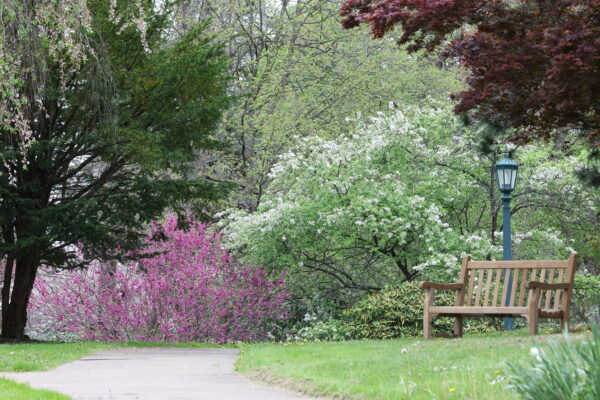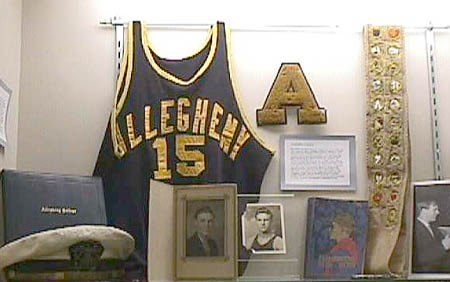
History
Allegheny College is the 32nd-oldest college in the United States. Discover the highlights of our more than 200 years of excellence.
Historic Highlights
Founded in 1815, Allegheny College ranks among the oldest 1% of colleges and universities in the United States. As many as 100 colleges were established and failed before the Civil War. Allegheny is one of the hardy survivors of that time — demonstrating the determination and vision of those early pioneers of higher education in America.
Allegheny is situated in Meadville, Pennsylvania, which was established in 1788 in the French Creek Valley, astride the route traversed by George Washington on his journey to Fort LeBoeuf a generation earlier. In 1815, Meadville was still a raw frontier town of about 400 settlers, of whom an unusually large number had come from Massachusetts and Connecticut. They dreamed of a college that might bring the educational opportunities of New England to the frontier. The Rev. Timothy Alden was recruited to take on the task, and 2 months after his arrival in April 1815, Allegheny was established with Alden as its first president.
Within half a dozen years, Alden succeeded in attracting sufficient funds to begin building a campus. In the 1820s, the need of a building to house a library led to the construction of Bentley Hall. Designed by Alden, this handsome structure still crowns the hill on which the campus is located. It is named in honor of Dr. William Bentley, who donated his outstanding private library to the College.
Each year, as part of the Commencement ceremony, seniors march through the doors of historic Bentley Hall toward the adventures that await them.
Bentley Hall Renovation
Iconic Bentley Hall recently underwent a multi-year historically sensitive and sustainable renovation to restore its luster as one of America’s foremost examples of Federalist architecture.
Celebrating 200 Years
In 2015, Allegheny celebrated its 200-year history and the extraordinary futures of the graduates of the next century. Since then, faculty, staff, and students continue to innovate within a unique and vibrant multidisciplinary learning environment, celebrating the achievements of students and graduates who go on to contribute to the world around them.
Contains excerpts from Through All the Years: A History of Allegheny College by Jonathan E. Helmreich, Emeritus Professor of History and College Historian
Historic Photos
Take a walk down memory lane with this collection of historic photos from the Allegheny archive.
Ida Tarbell, 1857-1944
Ida Minerva Tarbell (1857-1944), who went on to a notable career as a journalist and historian, is one of the College’s most notable alumnae. Her most renowned work was an exposé of the practices of oil magnate and philanthropist John D. Rockefeller in her “History of the Standard Oil Company” in 1904. She later served the College as a visiting lecturer, course instructor, donor of books, trustee, and advisor to presidents, and her desk can still be seen in the special collections of Allegheny’s Pelletier Library.
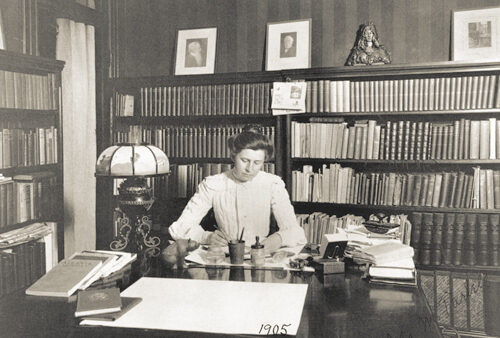
Campus, College Newspaper, 1876
The Campus of Allegheny College, the official College newspaper, was born in 1876. Initially funded by faculty members, the publication is now familiarly called the Campus.
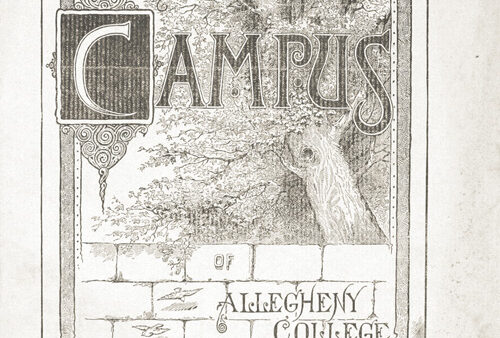
Newton Observatory, 1902
The 9-inch telescope installed in Newton Observatory in 1902 is still used today and considered of truly high quality. A sidereal clock installed the same year is now on display in Pelletier Library.
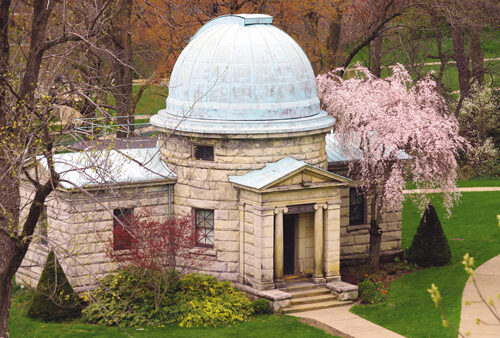
Rustic Bridge, 1910
Varying traditions surround the Rustic Bridge, constructed in 1910. In the first years after completion of the bridge, the Senior Class Day speeches were delivered from the bridge to the audiences seated below. The 13th plank — no one knows from which end — has remained an item of interest. In the mid-20th century, taking the plank liberated freshmen from sophomore tyranny. Tradition also said that a first-year woman was not truly an Alleghenian until kissed on the 13th plank. Even today it isn’t unusual to see the 13th plank missing at any time throughout the year.

Senior Comp, 1951
One of the proudest accomplishments for any Allegheny student is the Senior Comprehensive Project, or “comp.” The comp is a significant piece of original, scholarly work required of all Allegheny students. A description of the senior independent project as a formal graduation requirement is first found in the Allegheny College catalog of August 1951.

Fun Facts
When you’ve been around as long as we have, you collect a lot of interesting historical facts.
- Allegheny College was originally spelled “Alleghany College” when Timothy Alden first founded it in 1815.
- Legend has it that Timothy Alden himself planted the great sycamore in front of Bentley Hall in 1822 under the classical belief that certain trees planted at the southwest corner of a building would bring prosperity to the building’s inhabitants.
- Allegheny College is the oldest college in continuous existence under the same name west of the Allegheny Mountains.
- In December 1905, Allegheny’s President Crawford presented his views about the moral health of intercollegiate sports to a meeting in New York City. Out of that gathering would come the National Collegiate Athletic Association (NCAA), with Allegheny as one of its 17 charter members.
- In 1901, Allegheny became host to the 51st chapter of Phi Beta Kappa. The purpose of the society, from its beginning in Williamsburg, Virginia, in 1775, was to promote scholarship, friendship, and, in more recent decades, the liberal arts.
- The “Rules for Freshmen Men,” published in 1919-1920 “by order of the student senate,” included directives such as:
- Freshmen must use only the sidewalks on the campus
- Freshmen must wear black sox and black sox only
- Freshmen must build college bon-fires when so directed by the College Cheer-Leader
- In 1906, Allegheny was one of the original institutions to establish the NCAA.
- In a letter dated 1824, Thomas Jefferson praised the college’s library catalogue, saying “I had not expected there was such a private collection in the U.S.”
People From Our Past

Meet the individuals whose strong leadership and clear vision have enabled Allegheny to earn and maintain a premier reputation lasting more than 2 centuries.
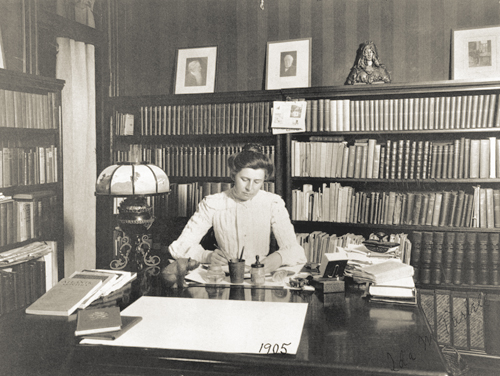
America’s first great investigative journalist, Ida M. Tarbell, graduated from Allegheny in 1880 and went on to write “The History of the Standard Oil Company.”

Pennsylvania’s 39th governor, Raymond P. Shafer was a 1938 graduate of Allegheny who went on to graduate from Yale Law School in 1941.
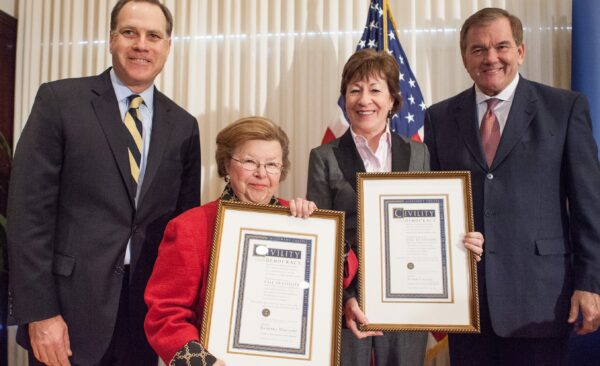
The Allegheny College Prizes for Civility recognized national figures, state individuals, and students who demonstrate a passion for, and clear understanding of, civility.
Military History
Over the course of Allegheny’s more than 200 years, we have shared a rich history of association with the military.
Archives
The Merrick Archive Center collects, preserves, and makes available for research historical records of enduring value to the institution.
Learn More About Allegheny


